Article
The Zeigarnik Effect and What Neuroscience Means to Email Marketers
May 20, 2019

Nearly 100 years ago, Prussian psychologist Kurt Lewin had a revelation at a restaurant: Waiters seemed to have much better memories for orders that weren’t yet paid. His student, Bluma Zeigarnik, took this revelation and researched it, publishing a report concluding that people better remember incomplete or interrupted tasks rather than those checked off their to-do lists.
What does the Zeigarnik Effect have to do with email marketing? Plenty, according to our friends at Emma.
Your Brain on Email: The Science to Winning the Inbox is new research that explores how psychology helps email marketers. For one, the Zeigarnik Effect suggests that our brains are hard-wired to want to…
…finish reading sentences. See? Email marketers can play on that natural impulse, boosting open rates by including ellipses in their subject lines.
- Saks Fifth Avenue: These Met Gala-inspired pieces are pink carpet-approved…

- eBay: ????Wow! Items to make you smile…

- Menlo Club: You’ll want to be a part of this…

Saks shoppers are especially fashion-conscious, while eBay customers love a good deal. Both of those subject lines play on people’s natural inclination to fill in the blanks, while keeping their respective audiences in mind. Menlo Park’sre-engagement campaign is another great example of the Zeigarnik Effect in action; what do we want to be a part of?!
The Zeigarnik Effect is just one topic Emma explores in Your Brain on Email. Download the guide to learn more about neuroscience in email marketing, including:
- The importance of a compelling subject line, given our primitive lizard brains — or the amygdala — make snap decisions in three seconds or less
- What makes nostalgia and user-generated content so powerful
- Why we’re drawn to the “buy one, donate one” model used by brands like TOMS and Warby Parker
- The Von Restorff Effect that explains why big, bold call-to-action buttons are so irresistible.
The State of Brand Loyalty in the U.S. in 2023
Related



